Economics and Finance: Capitalism, Inflation, Equilibrium Price, PESTLE Analysis, Public Goods and Monopoly
VerifiedAdded on 2023/06/15
|11
|3187
|383
AI Summary
This article covers topics related to capitalism, inflation, equilibrium price, PESTLE analysis, public goods and monopoly. It also analyzes the financial performance of Tesco Company in comparison to its competitors.
Contribute Materials
Your contribution can guide someone’s learning journey. Share your
documents today.
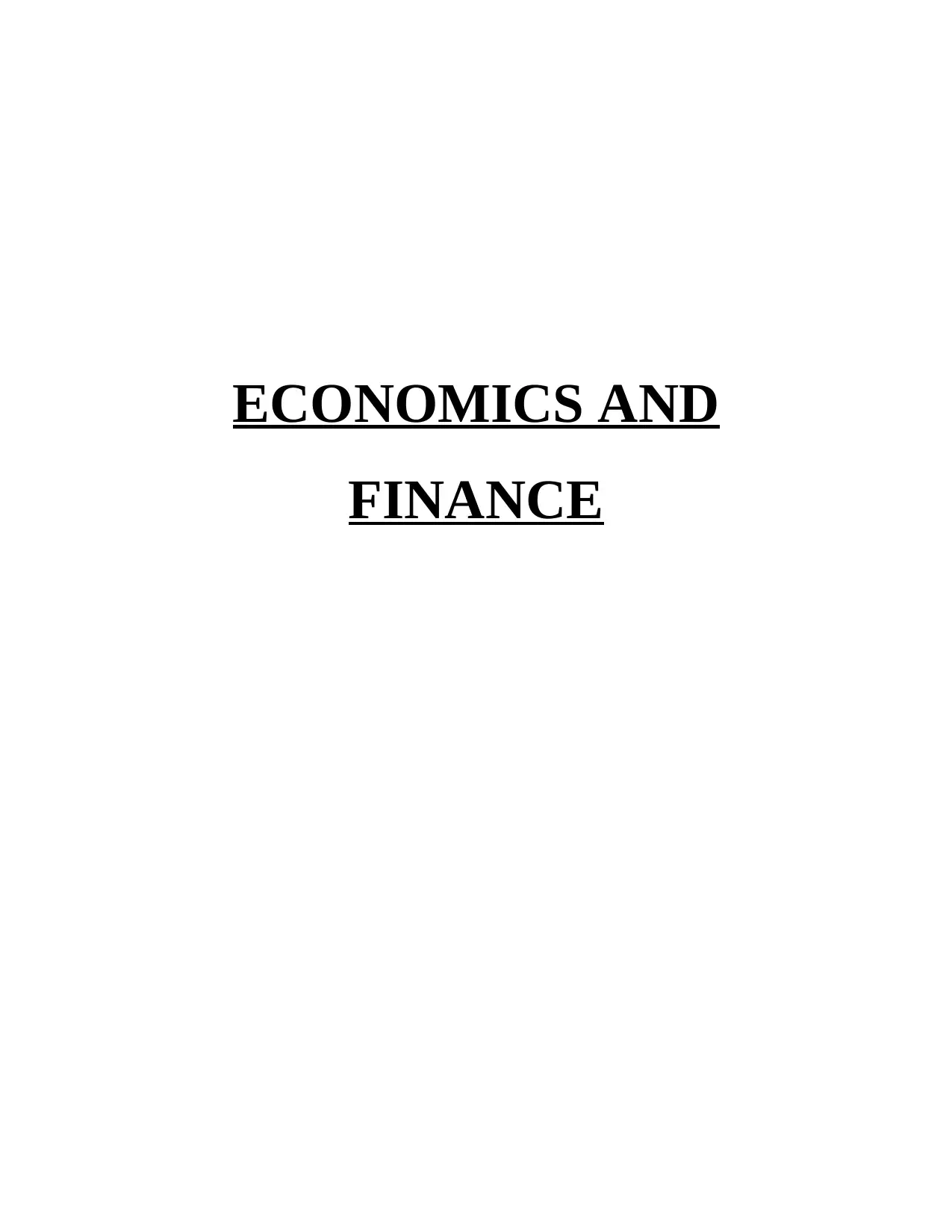
ECONOMICS AND
FINANCE
FINANCE
Secure Best Marks with AI Grader
Need help grading? Try our AI Grader for instant feedback on your assignments.
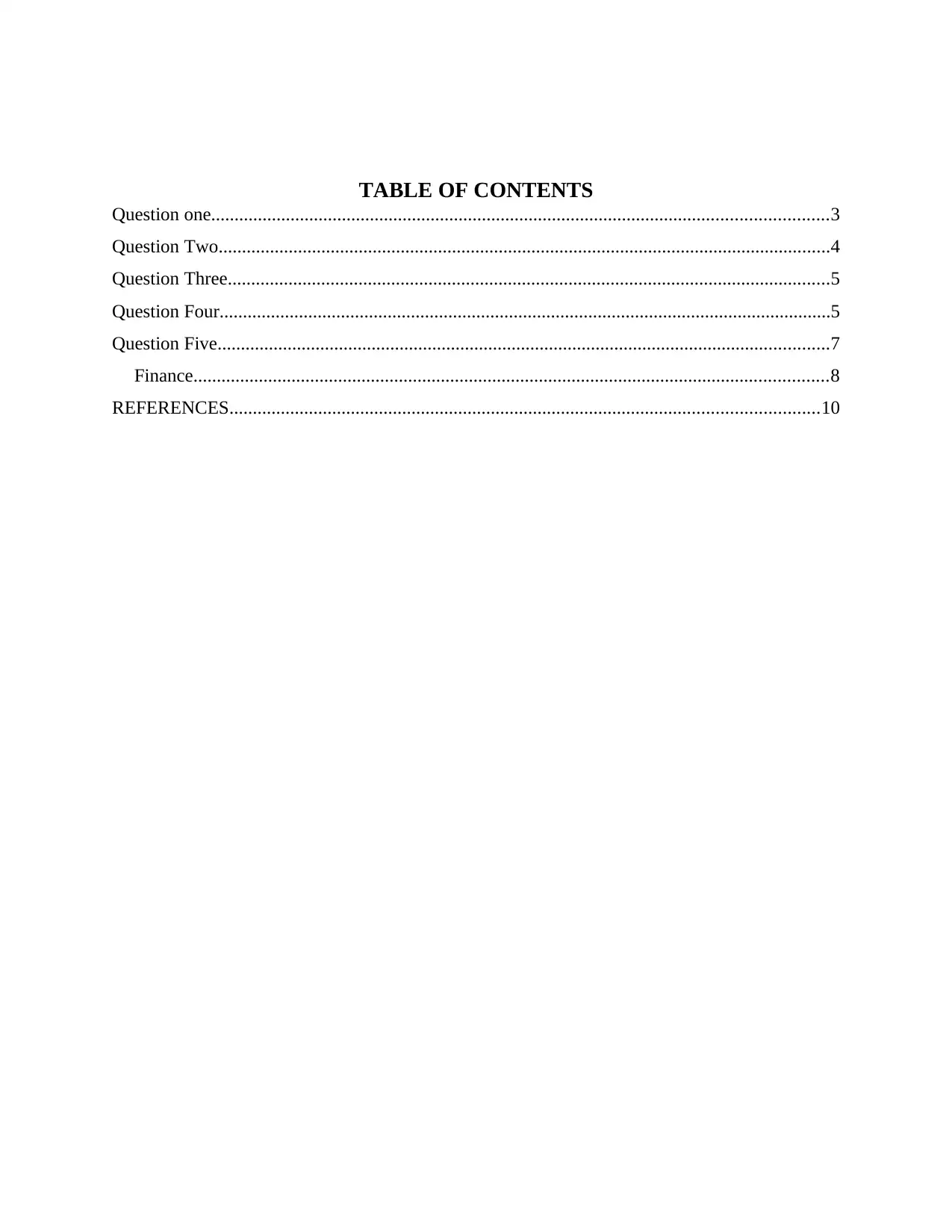
TABLE OF CONTENTS
Question one....................................................................................................................................3
Question Two...................................................................................................................................4
Question Three.................................................................................................................................5
Question Four...................................................................................................................................5
Question Five...................................................................................................................................7
Finance........................................................................................................................................8
REFERENCES..............................................................................................................................10
Question one....................................................................................................................................3
Question Two...................................................................................................................................4
Question Three.................................................................................................................................5
Question Four...................................................................................................................................5
Question Five...................................................................................................................................7
Finance........................................................................................................................................8
REFERENCES..............................................................................................................................10
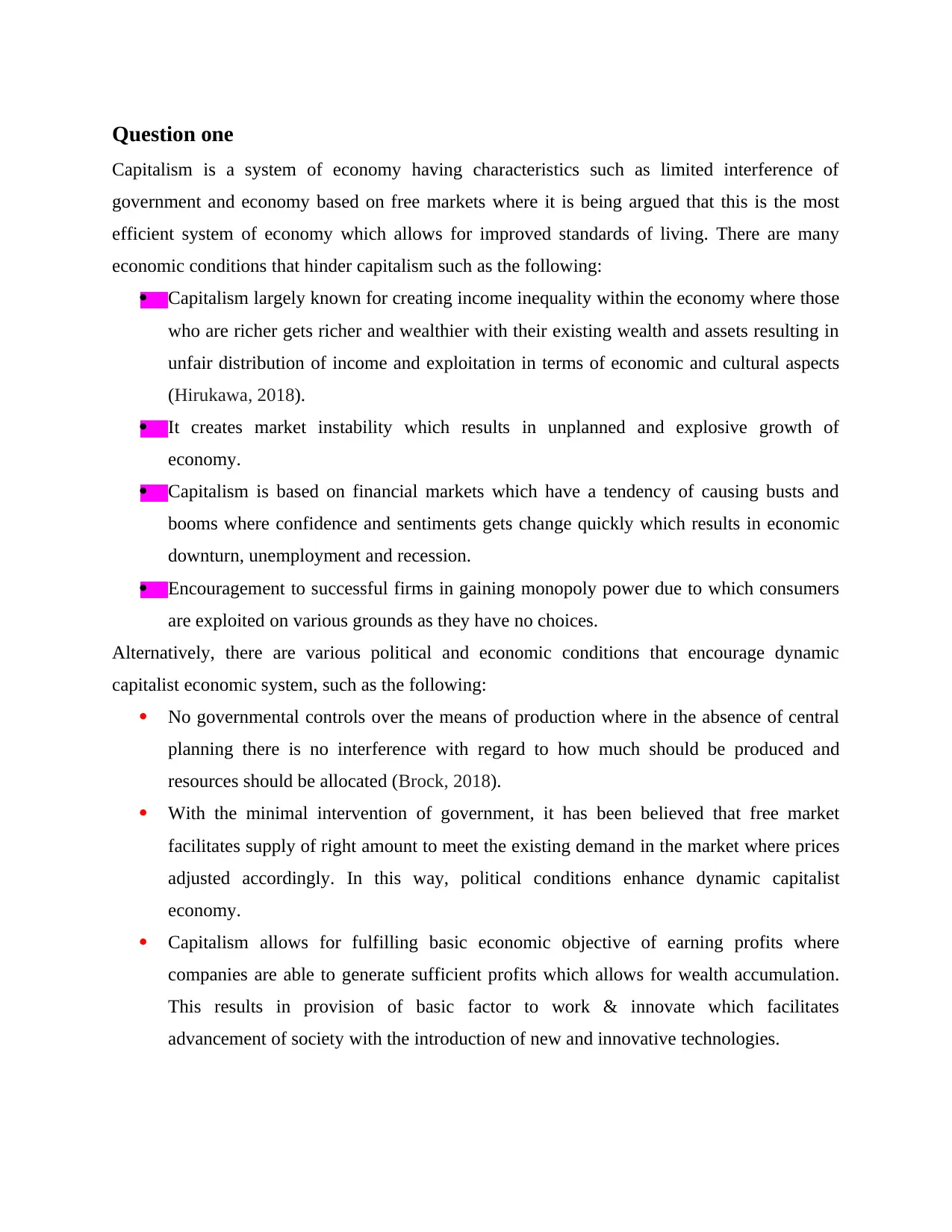
Question one
Capitalism is a system of economy having characteristics such as limited interference of
government and economy based on free markets where it is being argued that this is the most
efficient system of economy which allows for improved standards of living. There are many
economic conditions that hinder capitalism such as the following:
Capitalism largely known for creating income inequality within the economy where those
who are richer gets richer and wealthier with their existing wealth and assets resulting in
unfair distribution of income and exploitation in terms of economic and cultural aspects
(Hirukawa, 2018).
It creates market instability which results in unplanned and explosive growth of
economy.
Capitalism is based on financial markets which have a tendency of causing busts and
booms where confidence and sentiments gets change quickly which results in economic
downturn, unemployment and recession.
Encouragement to successful firms in gaining monopoly power due to which consumers
are exploited on various grounds as they have no choices.
Alternatively, there are various political and economic conditions that encourage dynamic
capitalist economic system, such as the following:
No governmental controls over the means of production where in the absence of central
planning there is no interference with regard to how much should be produced and
resources should be allocated (Brock, 2018).
With the minimal intervention of government, it has been believed that free market
facilitates supply of right amount to meet the existing demand in the market where prices
adjusted accordingly. In this way, political conditions enhance dynamic capitalist
economy.
Capitalism allows for fulfilling basic economic objective of earning profits where
companies are able to generate sufficient profits which allows for wealth accumulation.
This results in provision of basic factor to work & innovate which facilitates
advancement of society with the introduction of new and innovative technologies.
Capitalism is a system of economy having characteristics such as limited interference of
government and economy based on free markets where it is being argued that this is the most
efficient system of economy which allows for improved standards of living. There are many
economic conditions that hinder capitalism such as the following:
Capitalism largely known for creating income inequality within the economy where those
who are richer gets richer and wealthier with their existing wealth and assets resulting in
unfair distribution of income and exploitation in terms of economic and cultural aspects
(Hirukawa, 2018).
It creates market instability which results in unplanned and explosive growth of
economy.
Capitalism is based on financial markets which have a tendency of causing busts and
booms where confidence and sentiments gets change quickly which results in economic
downturn, unemployment and recession.
Encouragement to successful firms in gaining monopoly power due to which consumers
are exploited on various grounds as they have no choices.
Alternatively, there are various political and economic conditions that encourage dynamic
capitalist economic system, such as the following:
No governmental controls over the means of production where in the absence of central
planning there is no interference with regard to how much should be produced and
resources should be allocated (Brock, 2018).
With the minimal intervention of government, it has been believed that free market
facilitates supply of right amount to meet the existing demand in the market where prices
adjusted accordingly. In this way, political conditions enhance dynamic capitalist
economy.
Capitalism allows for fulfilling basic economic objective of earning profits where
companies are able to generate sufficient profits which allows for wealth accumulation.
This results in provision of basic factor to work & innovate which facilitates
advancement of society with the introduction of new and innovative technologies.
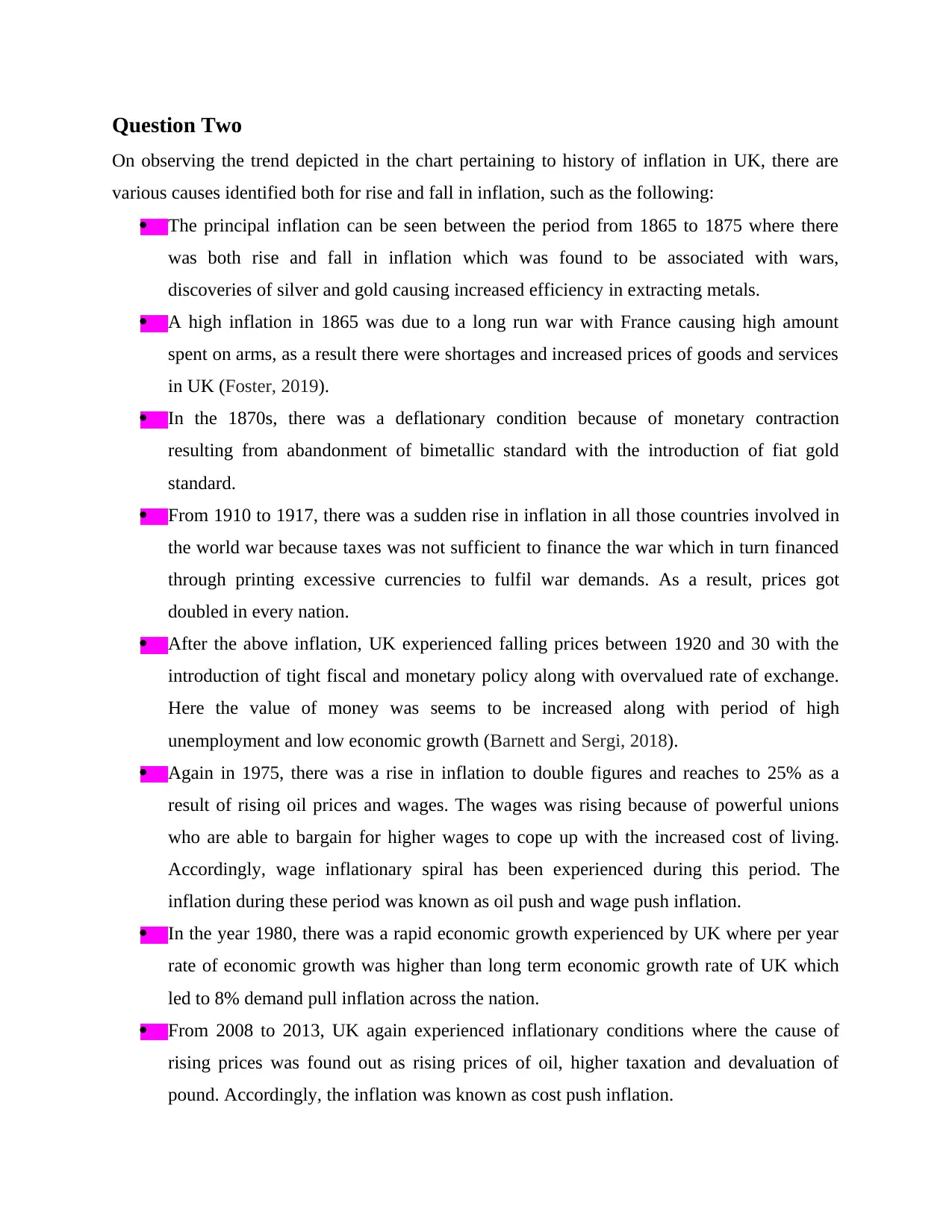
Question Two
On observing the trend depicted in the chart pertaining to history of inflation in UK, there are
various causes identified both for rise and fall in inflation, such as the following:
The principal inflation can be seen between the period from 1865 to 1875 where there
was both rise and fall in inflation which was found to be associated with wars,
discoveries of silver and gold causing increased efficiency in extracting metals.
A high inflation in 1865 was due to a long run war with France causing high amount
spent on arms, as a result there were shortages and increased prices of goods and services
in UK (Foster, 2019).
In the 1870s, there was a deflationary condition because of monetary contraction
resulting from abandonment of bimetallic standard with the introduction of fiat gold
standard.
From 1910 to 1917, there was a sudden rise in inflation in all those countries involved in
the world war because taxes was not sufficient to finance the war which in turn financed
through printing excessive currencies to fulfil war demands. As a result, prices got
doubled in every nation.
After the above inflation, UK experienced falling prices between 1920 and 30 with the
introduction of tight fiscal and monetary policy along with overvalued rate of exchange.
Here the value of money was seems to be increased along with period of high
unemployment and low economic growth (Barnett and Sergi, 2018).
Again in 1975, there was a rise in inflation to double figures and reaches to 25% as a
result of rising oil prices and wages. The wages was rising because of powerful unions
who are able to bargain for higher wages to cope up with the increased cost of living.
Accordingly, wage inflationary spiral has been experienced during this period. The
inflation during these period was known as oil push and wage push inflation.
In the year 1980, there was a rapid economic growth experienced by UK where per year
rate of economic growth was higher than long term economic growth rate of UK which
led to 8% demand pull inflation across the nation.
From 2008 to 2013, UK again experienced inflationary conditions where the cause of
rising prices was found out as rising prices of oil, higher taxation and devaluation of
pound. Accordingly, the inflation was known as cost push inflation.
On observing the trend depicted in the chart pertaining to history of inflation in UK, there are
various causes identified both for rise and fall in inflation, such as the following:
The principal inflation can be seen between the period from 1865 to 1875 where there
was both rise and fall in inflation which was found to be associated with wars,
discoveries of silver and gold causing increased efficiency in extracting metals.
A high inflation in 1865 was due to a long run war with France causing high amount
spent on arms, as a result there were shortages and increased prices of goods and services
in UK (Foster, 2019).
In the 1870s, there was a deflationary condition because of monetary contraction
resulting from abandonment of bimetallic standard with the introduction of fiat gold
standard.
From 1910 to 1917, there was a sudden rise in inflation in all those countries involved in
the world war because taxes was not sufficient to finance the war which in turn financed
through printing excessive currencies to fulfil war demands. As a result, prices got
doubled in every nation.
After the above inflation, UK experienced falling prices between 1920 and 30 with the
introduction of tight fiscal and monetary policy along with overvalued rate of exchange.
Here the value of money was seems to be increased along with period of high
unemployment and low economic growth (Barnett and Sergi, 2018).
Again in 1975, there was a rise in inflation to double figures and reaches to 25% as a
result of rising oil prices and wages. The wages was rising because of powerful unions
who are able to bargain for higher wages to cope up with the increased cost of living.
Accordingly, wage inflationary spiral has been experienced during this period. The
inflation during these period was known as oil push and wage push inflation.
In the year 1980, there was a rapid economic growth experienced by UK where per year
rate of economic growth was higher than long term economic growth rate of UK which
led to 8% demand pull inflation across the nation.
From 2008 to 2013, UK again experienced inflationary conditions where the cause of
rising prices was found out as rising prices of oil, higher taxation and devaluation of
pound. Accordingly, the inflation was known as cost push inflation.
Secure Best Marks with AI Grader
Need help grading? Try our AI Grader for instant feedback on your assignments.
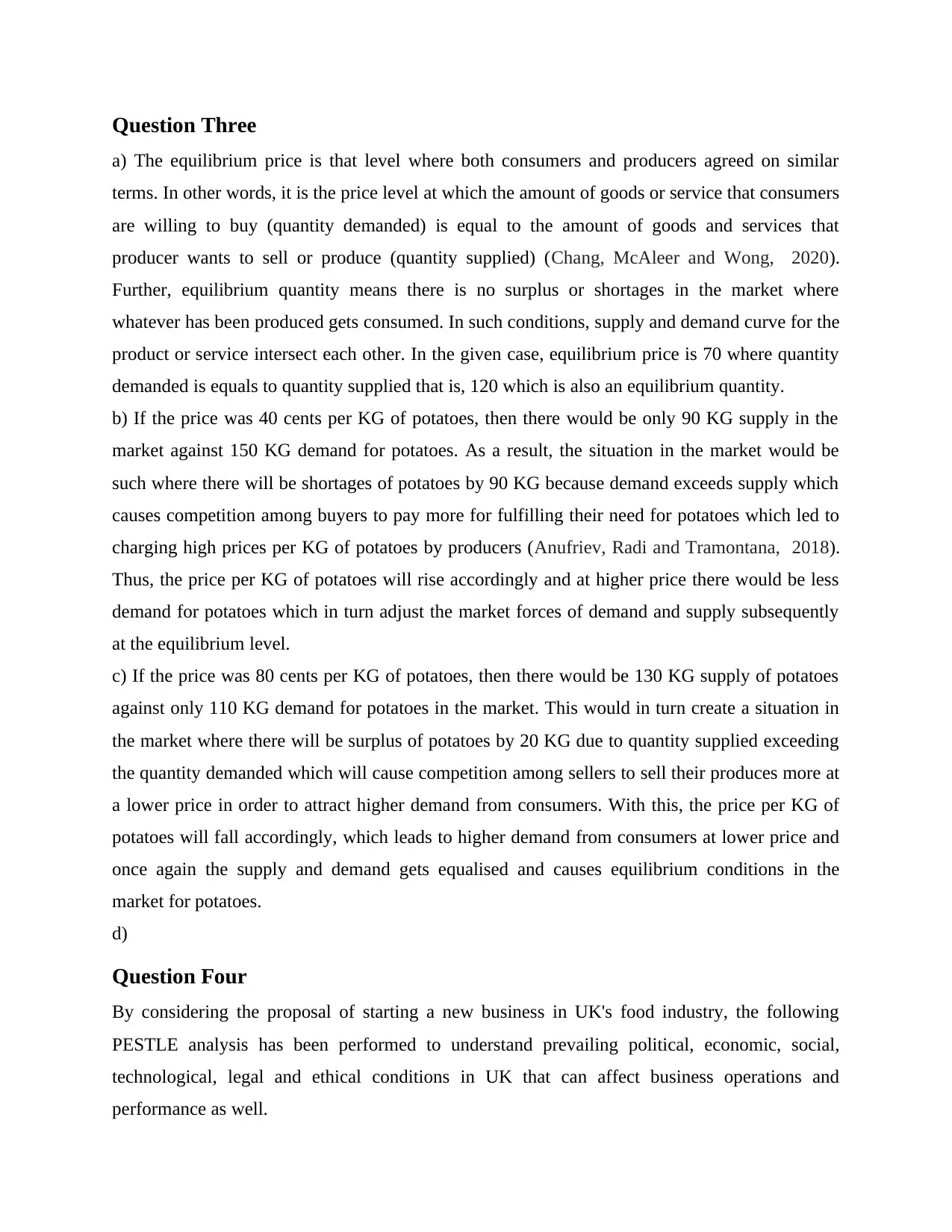
Question Three
a) The equilibrium price is that level where both consumers and producers agreed on similar
terms. In other words, it is the price level at which the amount of goods or service that consumers
are willing to buy (quantity demanded) is equal to the amount of goods and services that
producer wants to sell or produce (quantity supplied) (Chang, McAleer and Wong, 2020).
Further, equilibrium quantity means there is no surplus or shortages in the market where
whatever has been produced gets consumed. In such conditions, supply and demand curve for the
product or service intersect each other. In the given case, equilibrium price is 70 where quantity
demanded is equals to quantity supplied that is, 120 which is also an equilibrium quantity.
b) If the price was 40 cents per KG of potatoes, then there would be only 90 KG supply in the
market against 150 KG demand for potatoes. As a result, the situation in the market would be
such where there will be shortages of potatoes by 90 KG because demand exceeds supply which
causes competition among buyers to pay more for fulfilling their need for potatoes which led to
charging high prices per KG of potatoes by producers (Anufriev, Radi and Tramontana, 2018).
Thus, the price per KG of potatoes will rise accordingly and at higher price there would be less
demand for potatoes which in turn adjust the market forces of demand and supply subsequently
at the equilibrium level.
c) If the price was 80 cents per KG of potatoes, then there would be 130 KG supply of potatoes
against only 110 KG demand for potatoes in the market. This would in turn create a situation in
the market where there will be surplus of potatoes by 20 KG due to quantity supplied exceeding
the quantity demanded which will cause competition among sellers to sell their produces more at
a lower price in order to attract higher demand from consumers. With this, the price per KG of
potatoes will fall accordingly, which leads to higher demand from consumers at lower price and
once again the supply and demand gets equalised and causes equilibrium conditions in the
market for potatoes.
d)
Question Four
By considering the proposal of starting a new business in UK's food industry, the following
PESTLE analysis has been performed to understand prevailing political, economic, social,
technological, legal and ethical conditions in UK that can affect business operations and
performance as well.
a) The equilibrium price is that level where both consumers and producers agreed on similar
terms. In other words, it is the price level at which the amount of goods or service that consumers
are willing to buy (quantity demanded) is equal to the amount of goods and services that
producer wants to sell or produce (quantity supplied) (Chang, McAleer and Wong, 2020).
Further, equilibrium quantity means there is no surplus or shortages in the market where
whatever has been produced gets consumed. In such conditions, supply and demand curve for the
product or service intersect each other. In the given case, equilibrium price is 70 where quantity
demanded is equals to quantity supplied that is, 120 which is also an equilibrium quantity.
b) If the price was 40 cents per KG of potatoes, then there would be only 90 KG supply in the
market against 150 KG demand for potatoes. As a result, the situation in the market would be
such where there will be shortages of potatoes by 90 KG because demand exceeds supply which
causes competition among buyers to pay more for fulfilling their need for potatoes which led to
charging high prices per KG of potatoes by producers (Anufriev, Radi and Tramontana, 2018).
Thus, the price per KG of potatoes will rise accordingly and at higher price there would be less
demand for potatoes which in turn adjust the market forces of demand and supply subsequently
at the equilibrium level.
c) If the price was 80 cents per KG of potatoes, then there would be 130 KG supply of potatoes
against only 110 KG demand for potatoes in the market. This would in turn create a situation in
the market where there will be surplus of potatoes by 20 KG due to quantity supplied exceeding
the quantity demanded which will cause competition among sellers to sell their produces more at
a lower price in order to attract higher demand from consumers. With this, the price per KG of
potatoes will fall accordingly, which leads to higher demand from consumers at lower price and
once again the supply and demand gets equalised and causes equilibrium conditions in the
market for potatoes.
d)
Question Four
By considering the proposal of starting a new business in UK's food industry, the following
PESTLE analysis has been performed to understand prevailing political, economic, social,
technological, legal and ethical conditions in UK that can affect business operations and
performance as well.
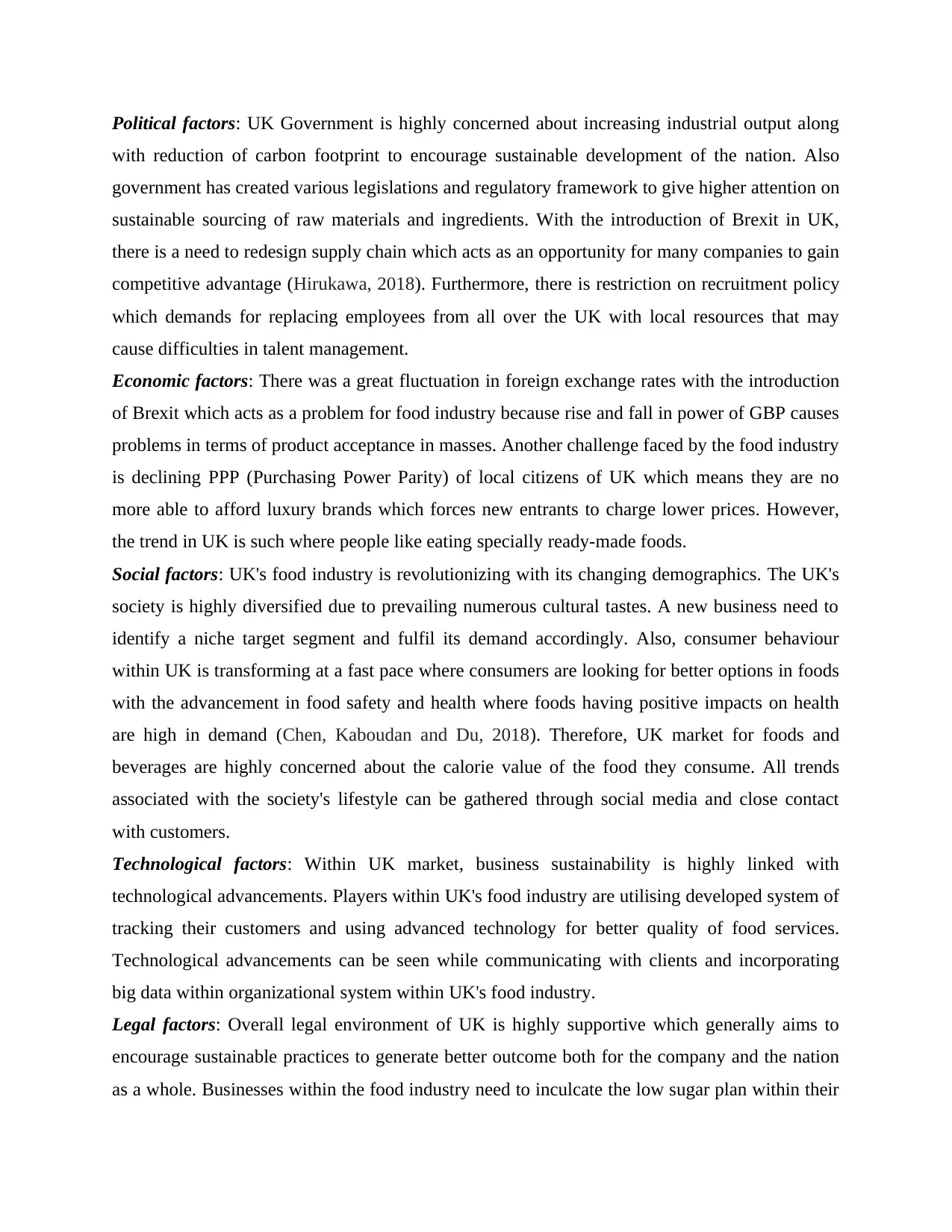
Political factors: UK Government is highly concerned about increasing industrial output along
with reduction of carbon footprint to encourage sustainable development of the nation. Also
government has created various legislations and regulatory framework to give higher attention on
sustainable sourcing of raw materials and ingredients. With the introduction of Brexit in UK,
there is a need to redesign supply chain which acts as an opportunity for many companies to gain
competitive advantage (Hirukawa, 2018). Furthermore, there is restriction on recruitment policy
which demands for replacing employees from all over the UK with local resources that may
cause difficulties in talent management.
Economic factors: There was a great fluctuation in foreign exchange rates with the introduction
of Brexit which acts as a problem for food industry because rise and fall in power of GBP causes
problems in terms of product acceptance in masses. Another challenge faced by the food industry
is declining PPP (Purchasing Power Parity) of local citizens of UK which means they are no
more able to afford luxury brands which forces new entrants to charge lower prices. However,
the trend in UK is such where people like eating specially ready-made foods.
Social factors: UK's food industry is revolutionizing with its changing demographics. The UK's
society is highly diversified due to prevailing numerous cultural tastes. A new business need to
identify a niche target segment and fulfil its demand accordingly. Also, consumer behaviour
within UK is transforming at a fast pace where consumers are looking for better options in foods
with the advancement in food safety and health where foods having positive impacts on health
are high in demand (Chen, Kaboudan and Du, 2018). Therefore, UK market for foods and
beverages are highly concerned about the calorie value of the food they consume. All trends
associated with the society's lifestyle can be gathered through social media and close contact
with customers.
Technological factors: Within UK market, business sustainability is highly linked with
technological advancements. Players within UK's food industry are utilising developed system of
tracking their customers and using advanced technology for better quality of food services.
Technological advancements can be seen while communicating with clients and incorporating
big data within organizational system within UK's food industry.
Legal factors: Overall legal environment of UK is highly supportive which generally aims to
encourage sustainable practices to generate better outcome both for the company and the nation
as a whole. Businesses within the food industry need to inculcate the low sugar plan within their
with reduction of carbon footprint to encourage sustainable development of the nation. Also
government has created various legislations and regulatory framework to give higher attention on
sustainable sourcing of raw materials and ingredients. With the introduction of Brexit in UK,
there is a need to redesign supply chain which acts as an opportunity for many companies to gain
competitive advantage (Hirukawa, 2018). Furthermore, there is restriction on recruitment policy
which demands for replacing employees from all over the UK with local resources that may
cause difficulties in talent management.
Economic factors: There was a great fluctuation in foreign exchange rates with the introduction
of Brexit which acts as a problem for food industry because rise and fall in power of GBP causes
problems in terms of product acceptance in masses. Another challenge faced by the food industry
is declining PPP (Purchasing Power Parity) of local citizens of UK which means they are no
more able to afford luxury brands which forces new entrants to charge lower prices. However,
the trend in UK is such where people like eating specially ready-made foods.
Social factors: UK's food industry is revolutionizing with its changing demographics. The UK's
society is highly diversified due to prevailing numerous cultural tastes. A new business need to
identify a niche target segment and fulfil its demand accordingly. Also, consumer behaviour
within UK is transforming at a fast pace where consumers are looking for better options in foods
with the advancement in food safety and health where foods having positive impacts on health
are high in demand (Chen, Kaboudan and Du, 2018). Therefore, UK market for foods and
beverages are highly concerned about the calorie value of the food they consume. All trends
associated with the society's lifestyle can be gathered through social media and close contact
with customers.
Technological factors: Within UK market, business sustainability is highly linked with
technological advancements. Players within UK's food industry are utilising developed system of
tracking their customers and using advanced technology for better quality of food services.
Technological advancements can be seen while communicating with clients and incorporating
big data within organizational system within UK's food industry.
Legal factors: Overall legal environment of UK is highly supportive which generally aims to
encourage sustainable practices to generate better outcome both for the company and the nation
as a whole. Businesses within the food industry need to inculcate the low sugar plan within their
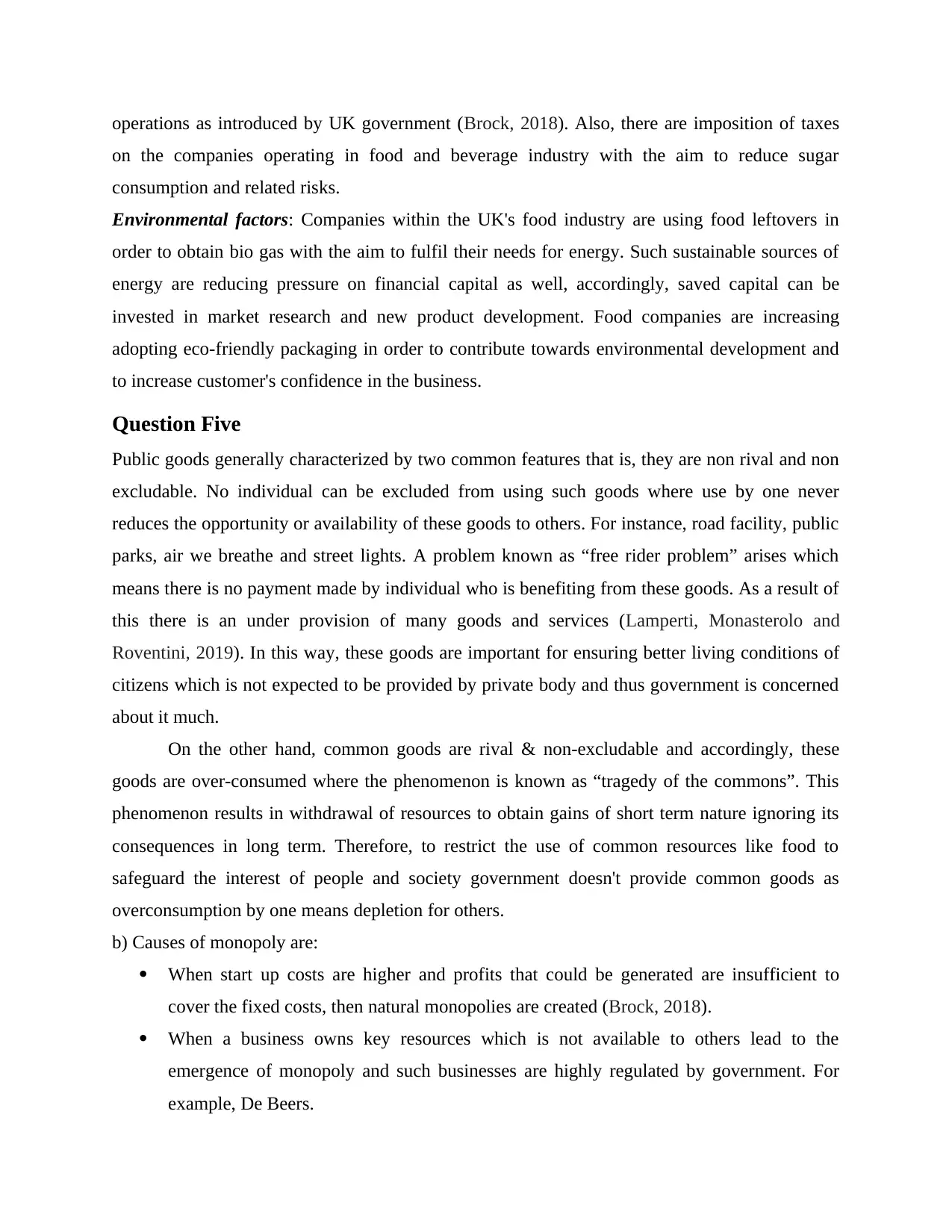
operations as introduced by UK government (Brock, 2018). Also, there are imposition of taxes
on the companies operating in food and beverage industry with the aim to reduce sugar
consumption and related risks.
Environmental factors: Companies within the UK's food industry are using food leftovers in
order to obtain bio gas with the aim to fulfil their needs for energy. Such sustainable sources of
energy are reducing pressure on financial capital as well, accordingly, saved capital can be
invested in market research and new product development. Food companies are increasing
adopting eco-friendly packaging in order to contribute towards environmental development and
to increase customer's confidence in the business.
Question Five
Public goods generally characterized by two common features that is, they are non rival and non
excludable. No individual can be excluded from using such goods where use by one never
reduces the opportunity or availability of these goods to others. For instance, road facility, public
parks, air we breathe and street lights. A problem known as “free rider problem” arises which
means there is no payment made by individual who is benefiting from these goods. As a result of
this there is an under provision of many goods and services (Lamperti, Monasterolo and
Roventini, 2019). In this way, these goods are important for ensuring better living conditions of
citizens which is not expected to be provided by private body and thus government is concerned
about it much.
On the other hand, common goods are rival & non-excludable and accordingly, these
goods are over-consumed where the phenomenon is known as “tragedy of the commons”. This
phenomenon results in withdrawal of resources to obtain gains of short term nature ignoring its
consequences in long term. Therefore, to restrict the use of common resources like food to
safeguard the interest of people and society government doesn't provide common goods as
overconsumption by one means depletion for others.
b) Causes of monopoly are:
When start up costs are higher and profits that could be generated are insufficient to
cover the fixed costs, then natural monopolies are created (Brock, 2018).
When a business owns key resources which is not available to others lead to the
emergence of monopoly and such businesses are highly regulated by government. For
example, De Beers.
on the companies operating in food and beverage industry with the aim to reduce sugar
consumption and related risks.
Environmental factors: Companies within the UK's food industry are using food leftovers in
order to obtain bio gas with the aim to fulfil their needs for energy. Such sustainable sources of
energy are reducing pressure on financial capital as well, accordingly, saved capital can be
invested in market research and new product development. Food companies are increasing
adopting eco-friendly packaging in order to contribute towards environmental development and
to increase customer's confidence in the business.
Question Five
Public goods generally characterized by two common features that is, they are non rival and non
excludable. No individual can be excluded from using such goods where use by one never
reduces the opportunity or availability of these goods to others. For instance, road facility, public
parks, air we breathe and street lights. A problem known as “free rider problem” arises which
means there is no payment made by individual who is benefiting from these goods. As a result of
this there is an under provision of many goods and services (Lamperti, Monasterolo and
Roventini, 2019). In this way, these goods are important for ensuring better living conditions of
citizens which is not expected to be provided by private body and thus government is concerned
about it much.
On the other hand, common goods are rival & non-excludable and accordingly, these
goods are over-consumed where the phenomenon is known as “tragedy of the commons”. This
phenomenon results in withdrawal of resources to obtain gains of short term nature ignoring its
consequences in long term. Therefore, to restrict the use of common resources like food to
safeguard the interest of people and society government doesn't provide common goods as
overconsumption by one means depletion for others.
b) Causes of monopoly are:
When start up costs are higher and profits that could be generated are insufficient to
cover the fixed costs, then natural monopolies are created (Brock, 2018).
When a business owns key resources which is not available to others lead to the
emergence of monopoly and such businesses are highly regulated by government. For
example, De Beers.
Paraphrase This Document
Need a fresh take? Get an instant paraphrase of this document with our AI Paraphraser
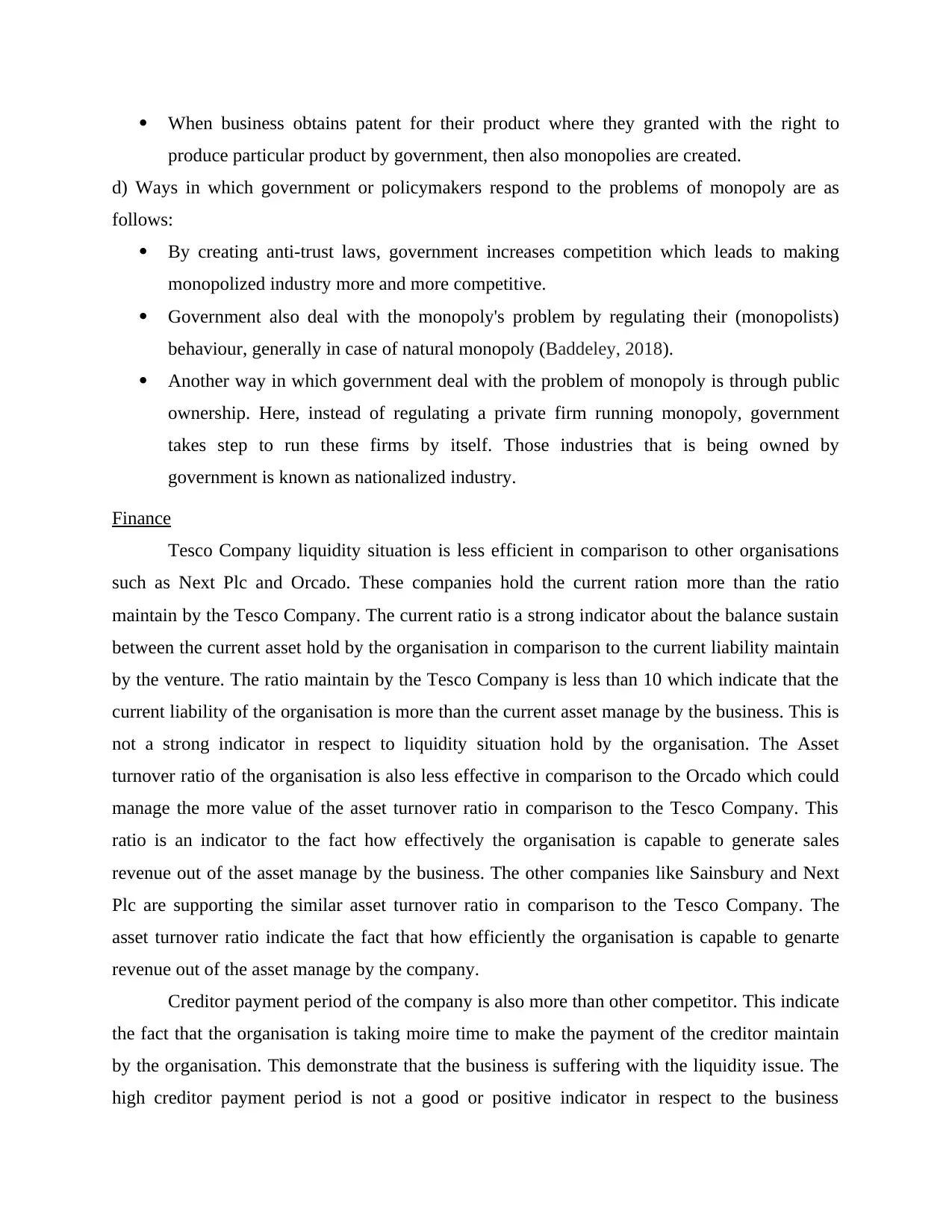
When business obtains patent for their product where they granted with the right to
produce particular product by government, then also monopolies are created.
d) Ways in which government or policymakers respond to the problems of monopoly are as
follows:
By creating anti-trust laws, government increases competition which leads to making
monopolized industry more and more competitive.
Government also deal with the monopoly's problem by regulating their (monopolists)
behaviour, generally in case of natural monopoly (Baddeley, 2018).
Another way in which government deal with the problem of monopoly is through public
ownership. Here, instead of regulating a private firm running monopoly, government
takes step to run these firms by itself. Those industries that is being owned by
government is known as nationalized industry.
Finance
Tesco Company liquidity situation is less efficient in comparison to other organisations
such as Next Plc and Orcado. These companies hold the current ration more than the ratio
maintain by the Tesco Company. The current ratio is a strong indicator about the balance sustain
between the current asset hold by the organisation in comparison to the current liability maintain
by the venture. The ratio maintain by the Tesco Company is less than 10 which indicate that the
current liability of the organisation is more than the current asset manage by the business. This is
not a strong indicator in respect to liquidity situation hold by the organisation. The Asset
turnover ratio of the organisation is also less effective in comparison to the Orcado which could
manage the more value of the asset turnover ratio in comparison to the Tesco Company. This
ratio is an indicator to the fact how effectively the organisation is capable to generate sales
revenue out of the asset manage by the business. The other companies like Sainsbury and Next
Plc are supporting the similar asset turnover ratio in comparison to the Tesco Company. The
asset turnover ratio indicate the fact that how efficiently the organisation is capable to genarte
revenue out of the asset manage by the company.
Creditor payment period of the company is also more than other competitor. This indicate
the fact that the organisation is taking moire time to make the payment of the creditor maintain
by the organisation. This demonstrate that the business is suffering with the liquidity issue. The
high creditor payment period is not a good or positive indicator in respect to the business
produce particular product by government, then also monopolies are created.
d) Ways in which government or policymakers respond to the problems of monopoly are as
follows:
By creating anti-trust laws, government increases competition which leads to making
monopolized industry more and more competitive.
Government also deal with the monopoly's problem by regulating their (monopolists)
behaviour, generally in case of natural monopoly (Baddeley, 2018).
Another way in which government deal with the problem of monopoly is through public
ownership. Here, instead of regulating a private firm running monopoly, government
takes step to run these firms by itself. Those industries that is being owned by
government is known as nationalized industry.
Finance
Tesco Company liquidity situation is less efficient in comparison to other organisations
such as Next Plc and Orcado. These companies hold the current ration more than the ratio
maintain by the Tesco Company. The current ratio is a strong indicator about the balance sustain
between the current asset hold by the organisation in comparison to the current liability maintain
by the venture. The ratio maintain by the Tesco Company is less than 10 which indicate that the
current liability of the organisation is more than the current asset manage by the business. This is
not a strong indicator in respect to liquidity situation hold by the organisation. The Asset
turnover ratio of the organisation is also less effective in comparison to the Orcado which could
manage the more value of the asset turnover ratio in comparison to the Tesco Company. This
ratio is an indicator to the fact how effectively the organisation is capable to generate sales
revenue out of the asset manage by the business. The other companies like Sainsbury and Next
Plc are supporting the similar asset turnover ratio in comparison to the Tesco Company. The
asset turnover ratio indicate the fact that how efficiently the organisation is capable to genarte
revenue out of the asset manage by the company.
Creditor payment period of the company is also more than other competitor. This indicate
the fact that the organisation is taking moire time to make the payment of the creditor maintain
by the organisation. This demonstrate that the business is suffering with the liquidity issue. The
high creditor payment period is not a good or positive indicator in respect to the business
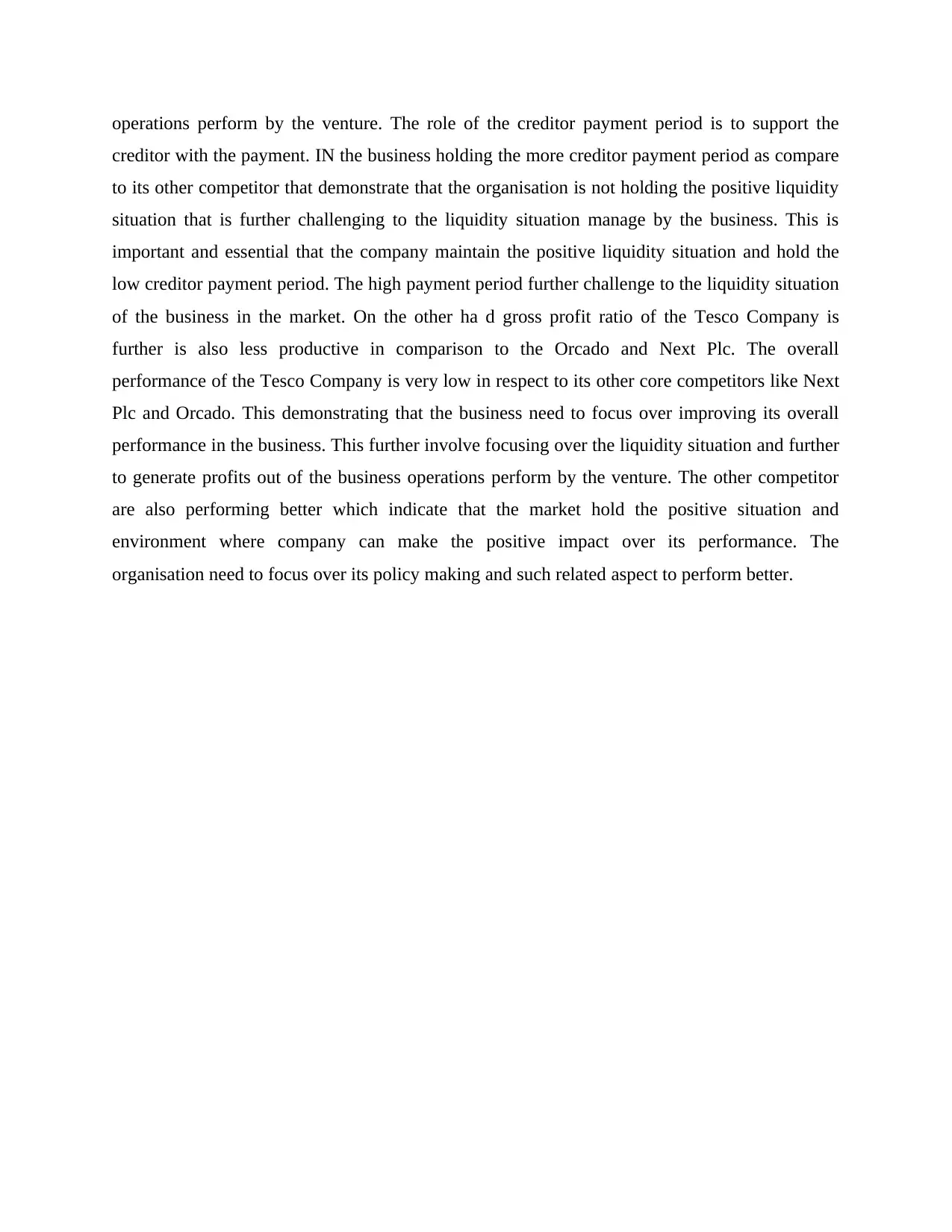
operations perform by the venture. The role of the creditor payment period is to support the
creditor with the payment. IN the business holding the more creditor payment period as compare
to its other competitor that demonstrate that the organisation is not holding the positive liquidity
situation that is further challenging to the liquidity situation manage by the business. This is
important and essential that the company maintain the positive liquidity situation and hold the
low creditor payment period. The high payment period further challenge to the liquidity situation
of the business in the market. On the other ha d gross profit ratio of the Tesco Company is
further is also less productive in comparison to the Orcado and Next Plc. The overall
performance of the Tesco Company is very low in respect to its other core competitors like Next
Plc and Orcado. This demonstrating that the business need to focus over improving its overall
performance in the business. This further involve focusing over the liquidity situation and further
to generate profits out of the business operations perform by the venture. The other competitor
are also performing better which indicate that the market hold the positive situation and
environment where company can make the positive impact over its performance. The
organisation need to focus over its policy making and such related aspect to perform better.
creditor with the payment. IN the business holding the more creditor payment period as compare
to its other competitor that demonstrate that the organisation is not holding the positive liquidity
situation that is further challenging to the liquidity situation manage by the business. This is
important and essential that the company maintain the positive liquidity situation and hold the
low creditor payment period. The high payment period further challenge to the liquidity situation
of the business in the market. On the other ha d gross profit ratio of the Tesco Company is
further is also less productive in comparison to the Orcado and Next Plc. The overall
performance of the Tesco Company is very low in respect to its other core competitors like Next
Plc and Orcado. This demonstrating that the business need to focus over improving its overall
performance in the business. This further involve focusing over the liquidity situation and further
to generate profits out of the business operations perform by the venture. The other competitor
are also performing better which indicate that the market hold the positive situation and
environment where company can make the positive impact over its performance. The
organisation need to focus over its policy making and such related aspect to perform better.
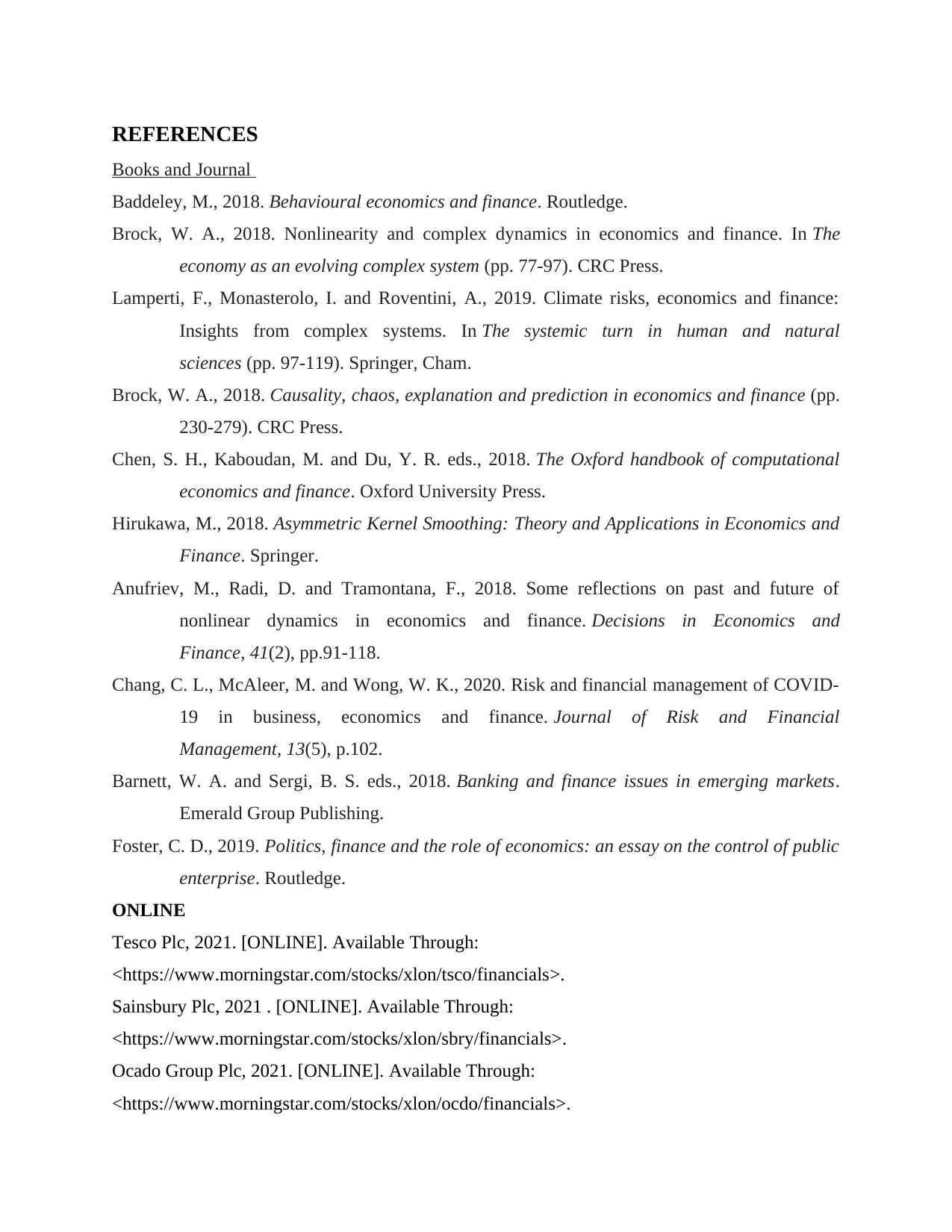
REFERENCES
Books and Journal
Baddeley, M., 2018. Behavioural economics and finance. Routledge.
Brock, W. A., 2018. Nonlinearity and complex dynamics in economics and finance. In The
economy as an evolving complex system (pp. 77-97). CRC Press.
Lamperti, F., Monasterolo, I. and Roventini, A., 2019. Climate risks, economics and finance:
Insights from complex systems. In The systemic turn in human and natural
sciences (pp. 97-119). Springer, Cham.
Brock, W. A., 2018. Causality, chaos, explanation and prediction in economics and finance (pp.
230-279). CRC Press.
Chen, S. H., Kaboudan, M. and Du, Y. R. eds., 2018. The Oxford handbook of computational
economics and finance. Oxford University Press.
Hirukawa, M., 2018. Asymmetric Kernel Smoothing: Theory and Applications in Economics and
Finance. Springer.
Anufriev, M., Radi, D. and Tramontana, F., 2018. Some reflections on past and future of
nonlinear dynamics in economics and finance. Decisions in Economics and
Finance, 41(2), pp.91-118.
Chang, C. L., McAleer, M. and Wong, W. K., 2020. Risk and financial management of COVID-
19 in business, economics and finance. Journal of Risk and Financial
Management, 13(5), p.102.
Barnett, W. A. and Sergi, B. S. eds., 2018. Banking and finance issues in emerging markets.
Emerald Group Publishing.
Foster, C. D., 2019. Politics, finance and the role of economics: an essay on the control of public
enterprise. Routledge.
ONLINE
Tesco Plc, 2021. [ONLINE]. Available Through:
<https://www.morningstar.com/stocks/xlon/tsco/financials>.
Sainsbury Plc, 2021 . [ONLINE]. Available Through:
<https://www.morningstar.com/stocks/xlon/sbry/financials>.
Ocado Group Plc, 2021. [ONLINE]. Available Through:
<https://www.morningstar.com/stocks/xlon/ocdo/financials>.
Books and Journal
Baddeley, M., 2018. Behavioural economics and finance. Routledge.
Brock, W. A., 2018. Nonlinearity and complex dynamics in economics and finance. In The
economy as an evolving complex system (pp. 77-97). CRC Press.
Lamperti, F., Monasterolo, I. and Roventini, A., 2019. Climate risks, economics and finance:
Insights from complex systems. In The systemic turn in human and natural
sciences (pp. 97-119). Springer, Cham.
Brock, W. A., 2018. Causality, chaos, explanation and prediction in economics and finance (pp.
230-279). CRC Press.
Chen, S. H., Kaboudan, M. and Du, Y. R. eds., 2018. The Oxford handbook of computational
economics and finance. Oxford University Press.
Hirukawa, M., 2018. Asymmetric Kernel Smoothing: Theory and Applications in Economics and
Finance. Springer.
Anufriev, M., Radi, D. and Tramontana, F., 2018. Some reflections on past and future of
nonlinear dynamics in economics and finance. Decisions in Economics and
Finance, 41(2), pp.91-118.
Chang, C. L., McAleer, M. and Wong, W. K., 2020. Risk and financial management of COVID-
19 in business, economics and finance. Journal of Risk and Financial
Management, 13(5), p.102.
Barnett, W. A. and Sergi, B. S. eds., 2018. Banking and finance issues in emerging markets.
Emerald Group Publishing.
Foster, C. D., 2019. Politics, finance and the role of economics: an essay on the control of public
enterprise. Routledge.
ONLINE
Tesco Plc, 2021. [ONLINE]. Available Through:
<https://www.morningstar.com/stocks/xlon/tsco/financials>.
Sainsbury Plc, 2021 . [ONLINE]. Available Through:
<https://www.morningstar.com/stocks/xlon/sbry/financials>.
Ocado Group Plc, 2021. [ONLINE]. Available Through:
<https://www.morningstar.com/stocks/xlon/ocdo/financials>.
Secure Best Marks with AI Grader
Need help grading? Try our AI Grader for instant feedback on your assignments.
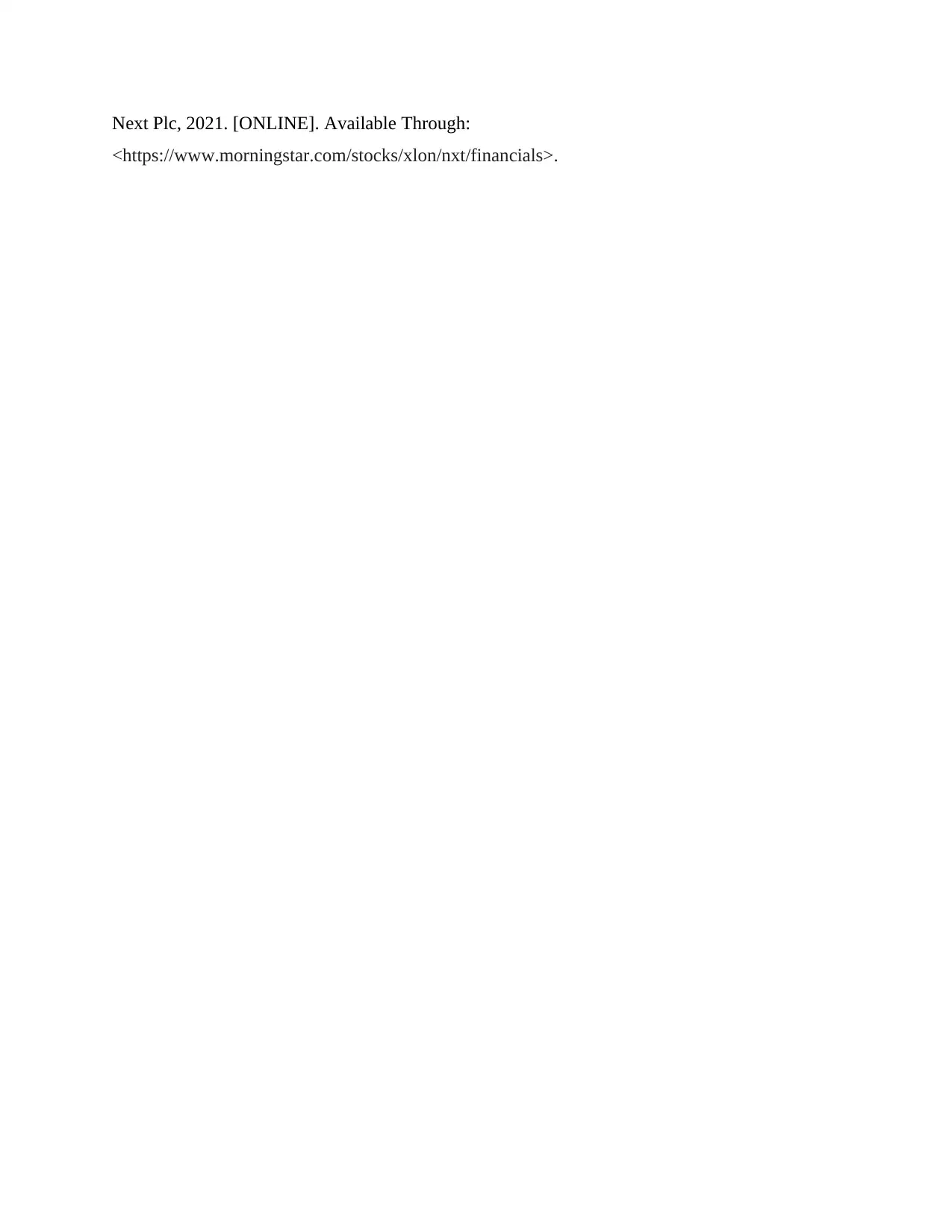
Next Plc, 2021. [ONLINE]. Available Through:
<https://www.morningstar.com/stocks/xlon/nxt/financials>.
<https://www.morningstar.com/stocks/xlon/nxt/financials>.
1 out of 11
Related Documents
Your All-in-One AI-Powered Toolkit for Academic Success.
+13062052269
info@desklib.com
Available 24*7 on WhatsApp / Email
![[object Object]](/_next/static/media/star-bottom.7253800d.svg)
Unlock your academic potential
© 2024 | Zucol Services PVT LTD | All rights reserved.





